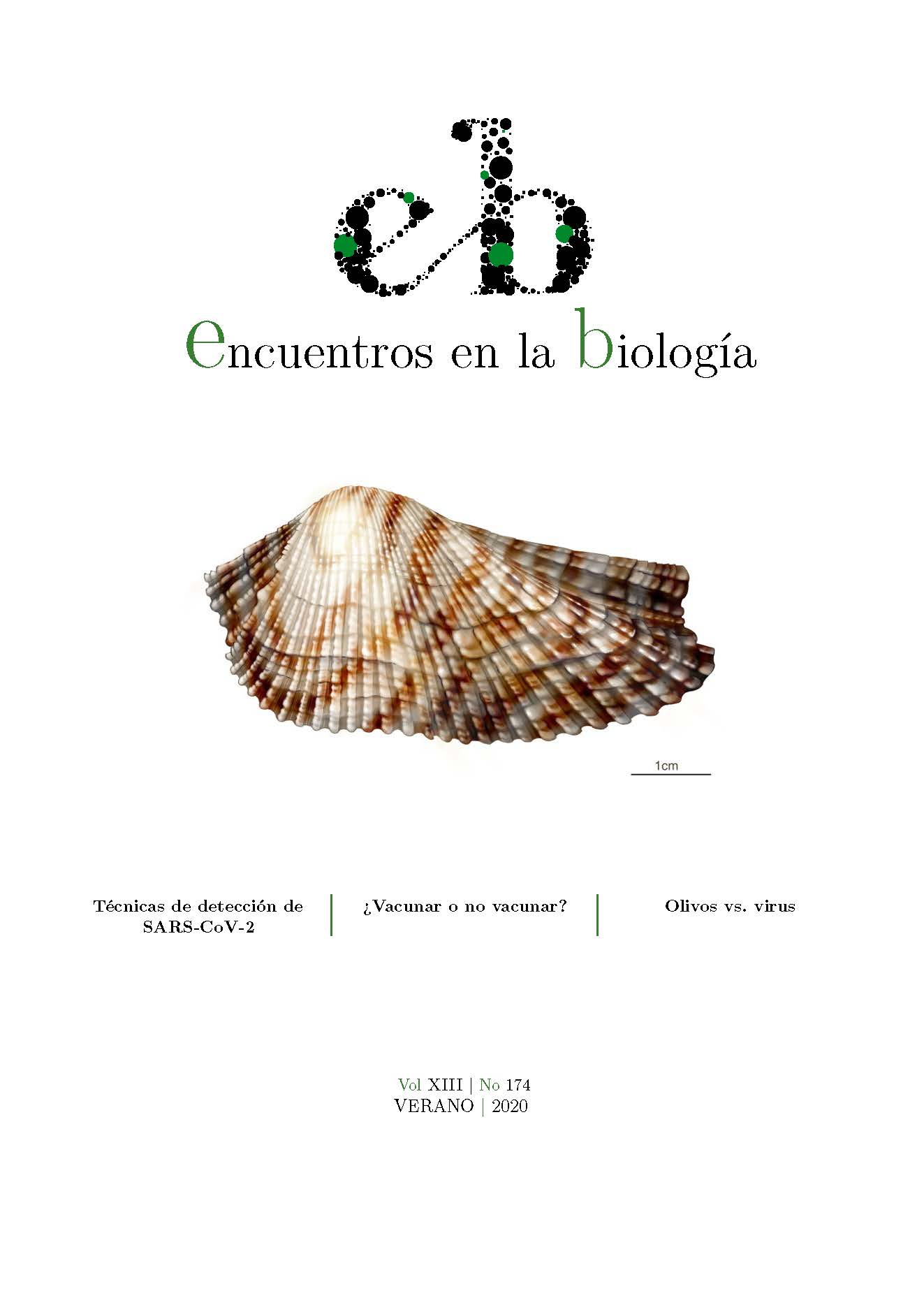Estabilidad genómica en Chondrichthyes, implicaciones en su evolución
DOI:
https://doi.org/10.24310/enbio.v13i174.17281Palabras clave:
macroevolución, quimeras, tiburones, rayasResumen
Nuevas técnicas de secuenciación molecular han permitido recientemente la secuenciación genética de cinco especies de Chondrichthyes: tiburón elefante (Callorhinchus milii), tiburón ballena (Rhincodon typus), tiburón bambú de bandas marrones (Chiloscyllium punctatum), tiburón gato (Scyliorhinus torazame) y tiburón blanco (Carcharhodon carcharias). Estos estudios han puesto de manifiesto que los Chondrichthyes presentan una elevada estabilidad genómica, por lo que presentan tasas evolutivas moleculares reducidas. Esta alta estabilidad genómica contrasta significativamente con la elevada variedad de ciclos biológicos, morfológicos, ecológicos y ecofisiológicos del grupo. El presente trabajo discute el papel de la estabilidad genómica en la evolución de los Chondrichthyes.
Descargas
Métricas
Publicación Facts
Perfil de revisores N/D
Información adicional autores
Indexado: {$indexList}
-
Indexado en
- Sociedad Académica/Grupo
- N/D
- Editora:
- Uma Editorial. Universidad de Málaga
Citas
Johri S y otros. Taking Advantage of the Genomics Revolu- tion for Monitoring and Conservation of Chondrichthyan Po- pulations. Diversity 11:49, 2019. https://doi.org/10.3390/ d11040049
Pimiento C y otros. Evolutionary pathways toward gigantism in sharks and rays. Evolution 73(3):588–599, 2019.
Renz AJ y otros. Revealing Less Derived Nature of Carti- laginous Fish Genomes with Their Evolutionary Time Scale Inferred with Nuclear Genes. PLoS ONE 8(6):e66400, 2013. http://dx.doi.org/10.1371/journal.pone.0066400
Venkatesh B y otros. Elephant shark genome provides unique insights into gnathostome evolution. Nature 505:174–179, 2014.
Read TD y otros. Draft sequencing and assembly of the ge- nome of the world’s largest fish, the whale shark: Rhinco- don typus Smith 1828. BMC Genomics 18:532, 2017. https://doi.org/10.1186/s12864-017-3926-9
Hara Y y otros. Shark genomes provide insights in- to elasmobranch evolution and the origin of vertebrates. Nat Ecol Evol 2:1761–1771, 2018. https://doi.org/10.1038/ s41559-018-0673-5
Marra NJ y otros. White shark genome reveals ancient elas- mobranch adaptations associated with wound healing and the maintenance of genome stability. Proc Natl Acad Sci USA 116(10):4446-4455, 2019. https://doi.org/10.1073/pnas.1819778116
Veríssimo A y otros. World without borders—genetic popu- lation structure of a highly migratory marine predator, the blue shark (Prionace glauca). Ecol Evol. 7: 4768–4781, 2017. https://doi.org/10.1002/ece3.2987
Bailleul D y otros. Large-scale genetic panmixia in the blue shark (Prionace glauca): A single worldwide population, or a ge- netic lag-time effect of the «grey zone» of differentiation? Evol Appl. 11:614–630, 2018. https://doi.org/10.1111/eva.12591
Camhi MD y otros. Sharks of the Open Ocean: Biology, Fishe- ries and Conservation. Ed. Wiley-Blackwell, 2008.
Bester-van der Merwe AE y otros. Population genetics of Southern Hemisphere tope shark (Galeorhinus galeus): Inter- continental divergence and constrained gene flow at different geographical scales. PLoS ONE 12(9): e0184481, 2017. https://doi.org/10.1371/journal.pone.0184481
Tubbs A y Nussenzweig A. Endogenous DNA Damage as a Source of Genomic Instability in Cancer. Cell. 168(4): 644-656, 2017. https://doi.org/10.1016/j.cell.2017.01.002
Chin A y otros. Blacktip reef sharks (Carcharhinus melanop- terus) show high capacity for wound healing and recovery fo- llowing injury. Conserv Physiol 3, 2015. https://doi.org/10. 1093/conphys/cov062
Ostrander GK y otros. Shark cartilage, cancer and the growing threat of pseudoscience. Cancer Res 64, 8485–8491, 2004.
Perry CT y otros. Comparing length-measurement methods and estimating growth parameters of free-swimming wha- le sharks (Rhincodon typus) near the South Ari Atoll, Maldives. Mar Freshwater Res 69(10):1487-1495, 2018. https://doi.org/10.1071/MF17393
Carmona R. y otros. Envejecimiento animal. Encuentros de la Biología 160: 152-156.
Pasquesi GLM y otros. Squamate reptiles challenge paradigms of genomic repeat element evolution set by birds and mammals. Nat Commun 9: 2774, 2018. https://doi.org/10.1038/s41467- 018-05279-1.
Suna YB y otros. Whole-genome sequence of the Tibetan frog Nanorana parkeri and the comparative evolution of tetrapod genomes. Proc Natl Acad Sci USA 112(11):E1257-E1262, 2015. https://doi.org/10.1073/pnas.1501764112
Descargas
Publicado
Cómo citar
Número
Sección
Licencia
Esta obra está bajo licencia internacional Creative Commons Reconocimiento-NoComercial-CompartirIgual 4.0.
Esta revista provee acceso libre inmediato a su contenido bajo el principio de hacer disponible gratuitamente la investigación al público. Todos los contenidos publicados en Encuentros en la Bilogía están sujetos a la licencia Creative Commons Reconocimento-NoComercia-Compartirigual 4.0 cuyo texto completo puede consultar en <http://creativecommons.org/licenses/by-nc-sa/4.0>
Se pueden copiar, usar, difundir, transmitir y exponer públicamente, siempre que:
Se cite la autoría y la fuente original de su publicación (revista, editorial y URL de la obra).
No se usen para fines comerciales.
Se mencione la existencia y especificaciones de esta licencia de uso
Los derechos de autor son de dos clases: morales y patrimoniales. Los derechos morales son prerrogativas perpetuas, irrenunciables, intransferibles, inalienables, inembargables e imprescriptibles. De acuerdo con la legislación de derechos de autor, Encuentros en la Biología reconoce y respeta el derecho moral de los autores/as, así como la titularidad del derecho patrimonial, el cual será cedido a la Universidad de Málaga para su difusión en acceso abierto. Los derechos patrimoniales, se refieren a los beneficios que se obtienen por el uso o divulgación de las obras. Encuentros en la Biología se publica en open access y queda autorizada en exclusiva para realizar o autorizar por cualquier medio el uso, distribución, divulgación, reproducción, adaptación, traducción o transformación de la obra.
Es responsabilidad de los autores/as obtener los permisos necesarios de las imágenes que están sujetas a derechos de autor.
Los autores/as cuyas contribuciones sean aceptadas para su publicación en esta revista conservarán el derecho no exclusivo de utilizar sus contribuciones con fines académicos, de investigación y educativos, incluyendo el auto-archivo o depósito en repositorios de acceso abierto de cualquier tipo.
La edición electrónica de esta revista esta editada por la Editorial de la Universidad de Málaga (UmaEditorial), siendo necesario citar la procedencia en cualquier reproducción parcial o total.






